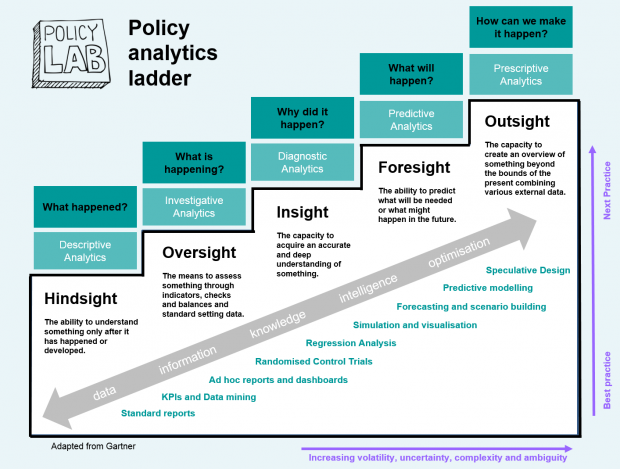
How new technologies are improving our tools for analysis and impact...
The Centre for Public Impact published a report earlier this year on policy impact with the Royal Society of Arts. It followed a number of roundtable meetings that discussed different aspects of future policy practice. You can download the full report here.
In my panel discussion I explained that the Policy Lab focuses on developing better ways to discover ‘next practice’ to build on, and contribute to, our ever expanding knowledge of ‘best practice’. At first glance the difference between the two might not be all that obvious. Yet in our experience, the mindset and practices are quite distinct. ‘Best practice’ seeks and explores what works by looking for examples where something has been done before and is therefore successfully proven. ‘Next practice’ in contrast has no precedent, it is future focused and therefore has many unknowns and ambiguities. It is one form of innovation. As former Harvard Professor Marco Steinberg, noted in his Institute for Government talk about the importance of understanding uncertain risks in change: “This kind of innovation is more like getting to the moon than crossing a street: it requires re-thinking the question at hand, rather than replicating against a benchmark.”
In the CPI report Barry Quirk, Chief Executive of Lewisham, distinguishes between the ‘art’ of politics, the ‘science’ of policy and the ‘craft’ of delivery. In the Policy Lab we bring these three distinct disciplines together, considering complex systems change using the power of all three. We work with hybrid knowledge, acting as what some academics call ‘boundary spanners’.

Bridging together different disciplines, crossing organisational boundaries and artificial silos is important when we think about next practice. When we think about the future we try and avoid limiting the possibilities too early. We know that multiple technology futures will collide in the real world as they meet social needs and wider economic forces. Our futures wheel shows just a few of the things that are likely to shape this future policy context. I recently created this to illustrate some of the emerging technologies that we are coming across in our projects. How these will blend together remains to be seen, but we can be sure that the context for future policy will be different to that from which our current evidence base was generated. After all, good science fiction is bound by the limits of what is imaginable at the time it was created (see Vasant’s recent blog on futures 'in the sky' and Cat’s on the future of rail).
We can use the past to predict the future, but we can’t ever fully account for the unknowns. Instead, we make ‘best guesses’ using abductive logic and put them in the world to test and evolve through a process of discovery and iteration. This is sometimes called design thinking, but is really abduction as Business Professor Roger Martin notes ‘Whether they realise it or not, designers live in Peirce’s world of abduction; they actively look for new data points, challenge accepted explanations, and infer possible new worlds’. Many of the Lab projects infer possible new worlds as the setting for future policies before testing and refining them. In our latest Slideshare I have added a policy ladder to start to map out different kinds of tools we have been using in the Policy Lab in the extremes of best practice and next practice.
I am optimistic about future because we have already seen so many advances in technology improving our collective lives over the last 100 years. The question is which ones will come next - and how might we adopt and adapt to them. Many of the tools we will need to analyse policy in the future have not yet been invented, which is why having a Policy Lab matters. As Alan Kay the creator of the computer Graphical User Interface once said ‘The best way to predict the future is to invent it.’
